Archive for the ‘Programming’ Category.
February 15, 2017, 21:00
We own a great VuPlus Solo2 Linux based Satelit Receiver. We record some series and films and then delete them. The deleted media files are not deleted directly when using EMC to view and delete. The media files are moved to a trash folder first and should be automatically deleted after x days. But that does not work for whatever reason.
Recently I checked the trash folders I found, as I wondered why the box’s hard disk is getting filled up. And I found many, many old ‘deleted’ files, that are not removed from the hard disk.
I decided to write my own script (/home/root/deltrasholder7days.sh, yes, there is a typo ;-)) ) to finally remove ‘deleted’ files after 7 days. The script was then added to the root’s crontab.
#!/bin/sh
# delete old files
# delete trash files older than 7 days
/usr/bin/find /mnt/hdd/movie_trash -type f -mtime +7 -delete
/usr/bin/find /mnt/hdd/movie/trashcan -type f -mtime +7 -delete
cd /mnt/hdd/movie_trash/
rm last_cleanup*
touch last_cleanup_$( date '+%Y-%m-%d_%H-%M-%S' )
cd /mnt/hdd/movie/trashcan/
rm last_cleanup*
touch last_cleanup_$( date '+%Y-%m-%d_%H-%M-%S' )
The script deletes all files at /mnt/hdd/movie_trash and /mnt/hdd/movie/trashcan with a modification date of 7 days before current day. Then it adds a file with a timestamp as name to let me know, that the script has worked at what time.
… and the crontab (/etc/cron/crontabs/root):
1 1 * * * /home/root/deltrasholder7days.sh
This starts the script every day at 1pm.
That’s all, thank’s to the author of the find utility.
October 20, 2016, 06:56
Some times ago I wrote a barcode scanner NPAPI plugin for the HTML5 browser by zetakey. It is based on code supplied as MySensor in the motorola knowledge base. The plugin is for Windows Mobile 6.x based devices by Intermec and another one for M3 devices.
The MySensor plugin based on npruntime was the only sample I could get to compile and work correctly. The barcode scanner fork I wrote does also work very well. The new MyDevinfo plugin retrieves model code, battery level and WLAN RSSI value of the Intermec device and allows to present this information to a HTML5 browser user when needed.
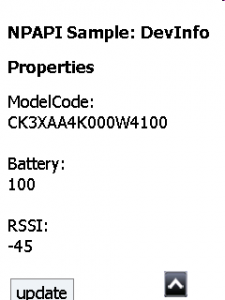
The above shows the web page of MyDevinfo_simple.htm.
Continue reading ‘NPAPI – a plugin to retrieve device information’ »
August 17, 2016, 20:26
As I already wrote the small demo apps for wireless printing of Label and Receipts for Android and Windows Phone 8, I now wrote such demo now for Windows UWP. The applciation was tested on a Windows 10 Phone running Windows 10 Iot Enterprise Edition.
The code is based on the Windows Universal Sample app BTRFCommChat, but uses a different, single page layout.
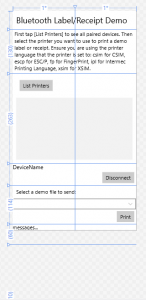
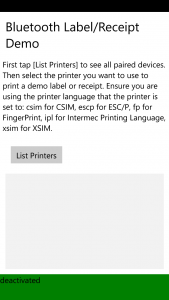
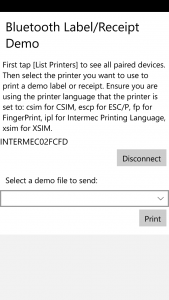
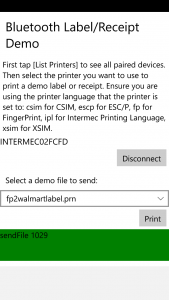
Continue reading ‘Development: Windows 10 UWP Wireless Label/Receipt printer demo’ »
July 19, 2016, 07:23
Nun kann ich ja Flugdaten mit Hilfe von Jonas Lieb’s py1090 und adsbox in FHEM aufzeichnen. Dies wollte ich immer um die Aufzeichnung des aktuellen Geräuschpegels erweitern. Das Ergebnis sind Erweiterungen der py1090 Klassen und bessere python Ausgaben der aktuellen Daten.
Angefangen habe ich mit einfachen print-Anweisungen und einer seriellen Verbindung zu einem Arduino Nano, der als ADC Wandler für den Geräuschpegel diente. Nun läuft ein nodeMCU mit espEasy. Dadurch (wireless) kann ich den Geräuschpegel ‘Sensor’ unabhängig positionieren. Die Daten lese ich in Python über json vom espEasy. Die aktuellen ‘Lärm’-Daten werden alle x Minuten über einen Python Telnet Client Code an FHEM übermittelt.
Aufbau
Geräuschpegel-Sensor => nodeMCU mit ESPeasy =(WLAN)=> Python Script => FHEM-Logfile + Telnet FHEM
Anfangs habe ich versucht den ‘Sender’-Code direkt in LUA auf dem nodeMCU zu schreiben. Man stösst aber sehr schnell an Speichergrenzen und der Code läuft sehr unzuverlässig. Dagegen ist ESPeasy total einfach einzurichten und bietet direkt einen ADC Sensor. Nun kann man den Wert via MQTT weiterverarbeiten. Da ich aber den Geräuschpegel zusammen mit dem aktuell ‘nächsten’ Flugzeug versenden will, lese ich die Daten via JSON von ESPeasy in Python und versende sie dann zusammen mit den Flugzeugdaten via Telnet an FHEM.
Das erste Python Script verwendet nur einfache Print-Ausgaben für die aktuellen Aktivitäten. Der Inhalt scrollt ständig über den Bildschirm und man hat keine Übersicht.
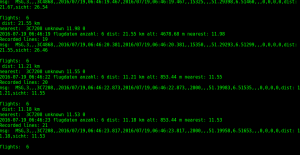
Daher habe ich den Python-Code so geändert, dass er zur Ausgabe curses verwendet:
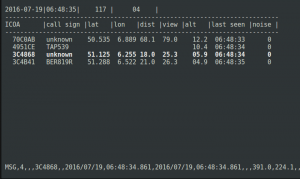
Leider ‘zerschiesst’ es ab und an den Bildschirm und die Hervorhebung für das ‘nächste’ Flugzeug erstreckt sich dann auch mal über andere Zeilen. Ausserdem kann man das Terminal Fenster nicht in der Größe ändern. Meistens bricht dann der Curses Code und das Python Script ab.
Dann habe ich es noch mit der Python blessings Erweiterung versucht:
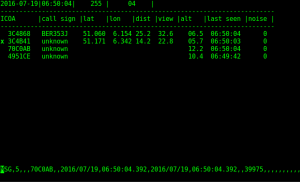
Nun kann man das Terminalfenster zwar im laufenden Betrieb in der Größe ändern, allerdings muß ich die Ausgabe noch besser anpassen (Kopfzeilen).
Ich habe in diesem Python Projekt möglichst mit Klassen und externen Modulen zu arbeiten. Dadurch kann man das Ganze leicht erweitern und anpassen.
Source Code












 http://www.led-mg.de
http://www.led-mg.de